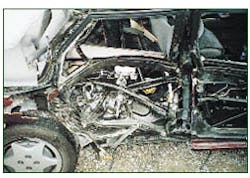How To Open Jammed Doors
Response personnel shall explain how to utilize the collision beam of a door to reduce the overall time required to open a jammed door.
Subject: Opening Jammed Doors
Topic: Door Collision Beams
Objective: Response personnel shall explain how to utilize the collision beam of a door to redcue the overall time required to open a jammed door.
Task:Using a functional door of an acquired vehicle, the rescuer shall identify the location of the collision beam(s) inside the door and demonstrate how door collision beam(s) can be utilized by rescuers during jammed door opening evolutions.Opening a jammed door can be a quick task or a long, drawn-out operation. A door that won’t open by normal means and is jammed or crushed only slightly should be able to be opened by rescuers in less than 60 seconds of evolution time. A severely crushed door can understandably take longer. The challenge, however, is to be able to open all doors as efficiently as possible, with a 60-second-or-less elapsed time as your evolution benchmark.
A tough door that is opened quickly indicates that the rescue crew located the door’s strong points and also recognized its weak areas. Weak areas are like tissue paper. We avoid these areas of the door during forcible entry work because they fail miserably when force is applied. The strong points of a jammed door are its hinges, the safety lock/latch mechanism and the internal collision beam(s). Although these components helped keep the door shut and the occupants inside the vehicle during the crash, they must now be effectively used by the rescue crew to get the door open.
The largest of the door’s strong points and its least visible component is its collision beam. The collision beam inside the jammed door can offer the rescue team a strong point to bend, pry, crush or push the door as it is forced open. Late-model vehicles reveal changes in collision beam design and location from what had been the norm. These changes affect the ability of rescue teams to open jammed doors.
Collision beams have evolved over the years since first being introduced with the 1973 model year. Vehicle doors can contain one or two round pipes, a flat steel structure similar to a highway guardrail, or a long, box-shaped beam. One significant collision beam change is the transition by several manufacturers to a stronger alloy metal for the beam itself. Metals such as the boron steel used by Volvo resist rescue cutting or sawing efforts.
The other significant change in collision beams is their location and orientation inside the door itself. In older vehicles, the door latch mechanism was always near the end of the collision beam and the beam always ran horizontally across the center point of front and rear doors. This is no longer true. Late-model vehicles can have their steel collision beams located low near the bottom of the door. Beams may be on severe angles inside a door or even crossed in an X fashion. Multiple beams or pipes may run parallel inside the door or be crossed or angled. There is no guarantee that the door latch mechanism will be at the end of the beam. This means that the door will tear more readily when forced because it is weak without the beam supporting it from inside.
In another new collision beam design, the door’s safety lock and latch assembly is actually secured directly to the collision beam itself. Note the end fold of the collision beam on the Dodge Stratus vehicle as an example of this design. The door’s safety latch is bolted through three holes in the end of the beam. Forcing a jammed door at or near this safety latch applies direct pressure to the beam. Force applied to the jammed latch will also cause movement to the entire door because pressure is being applied to the full-length collision beam as well. This may be good or this may be bad. Note that the forward end of the front and rear door beams are extremely low at the hinge area.
Attacking a door at its exposed hinges can also be done in a brief period if the tool operator uses the collision beam(s) to assist in exposing the hinges or forcing the door.
If a side collision has bowed the door inward toward those trapped inside, the collision beam also bends or twists inward. The “vertical crush” method of forcing the door is well designed to move the top of the door and then the interior panel of the door down and out in a smooth, rolling action.
Rescue crews assigned to size up, set up and open up jammed doors must assess the location and design of the collision beam(s) inside the door. Look for signs of the beam’s location as you assess crash damage to the door. Many times, you will see the skin of the door form fit to the contour of the collision beam. Knowledge of how to work with this strong point of the door will allow crews to attain the recommended benchmark of less than 60 seconds to open any jammed door.
Ron Moore, a Firehouse contributing editor, is a battalion chief and the training officer for the McKinney, TX, Fire Department. He also authors a monthly online article in the Firehouse.com “MembersZone” and serves as the Forum Moderator for the extrication section of the Firehouse.com website. Moore can be contacted directly at [email protected].
